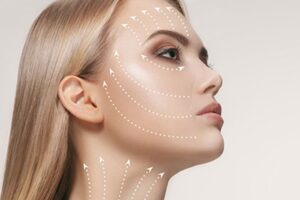When considering a facelift, understanding the differences between SMAS and Deep Plane techniques is essential. Both approaches offer unique benefits, targeting different facial layers to achieve youthful contours. In this guide, Dr. Kopelman explains the distinctions between these two facelift types, helping you choose the approach that best aligns with your aesthetic goals.
Table of Contents
ToggleWhat Is a SMAS Facelift? Understanding SMAS Facelift vs. Deep Plane
A SMAS facelift is a popular surgical technique that targets the Superficial Musculoaponeurotic System (SMAS), a layer of tissue and muscles beneath the skin.
By lifting and tightening this layer, the SMAS facelift restores youthful contours to the face and neck, addressing sagging skin, jowls, and fine lines.
This approach is known for providing natural results, particularly suited for moderate signs of aging.
SMAS Facelift vs. Deep Plane: Key Differences in Techniques
The primary difference between a SMAS facelift and a Deep Plane facelift lies in the depth of the tissue manipulation.
The SMAS facelift targets the superficial muscle layer, allowing for effective lifting and tightening of the skin. In contrast, the Deep Plane facelift reaches deeper tissue layers, offering a more substantial lift and repositioning of the midface and jawline.
While both techniques aim for facial rejuvenation, the Deep Plane facelift is often chosen for more pronounced aging and can achieve longer-lasting results.
What Is a SMAS Facelift? Basics and Benefits
A SMAS facelift is designed to lift and reposition the SMAS layer without disturbing deeper facial structures, providing a balanced, refreshed look.
This technique is less invasive than the Deep Plane facelift, making it suitable for individuals with moderate skin laxity who want natural enhancement with a quicker recovery time.
The SMAS facelift effectively improves the jawline, cheeks, and neck, giving a more youthful appearance with less downtime.
Deep Plane Facelift vs. SMAS Facelift: Comparing Techniques
When choosing between a Deep Plane facelift and a SMAS facelift, understanding the differences in techniques and targeted facial layers is essential for selecting the best approach for your rejuvenation goals.
Both procedures aim to lift and tighten the face, but they vary in depth and methods, leading to different results and recovery times.
Layers of the Face Targeted: Deep Plane vs. SMAS
The SMAS facelift focuses on the superficial layer known as the Superficial Musculoaponeurotic System (SMAS), addressing moderate sagging by lifting this layer without affecting deeper tissues.
In contrast, the Deep Plane facelift goes beyond the SMAS to reposition deeper facial layers, targeting the midface and jawline for a more comprehensive and long-lasting lift, especially for those with more advanced aging.
Surgical Techniques in SMAS vs. Deep Plane Facelift
The SMAS facelift involves lifting and tightening the SMAS layer, which is located just beneath the skin, resulting in natural, moderate improvements in facial contour.
Meanwhile, the Deep Plane facelift technique involves freeing and repositioning deeper facial layers, offering a more dramatic lift and improving overall facial volume and structure. This approach is often more complex but provides a robust and extended outcome.

Deep Plane Facelift vs. Facelift with SMAS – What’s the Difference?
The primary difference between the Deep Plane and SMAS facelifts lies in the depth and extent of tissue repositioning. The SMAS facelift achieves natural results with less invasive techniques, ideal for those with moderate aging signs.
The Deep Plane facelift, however, is suitable for more advanced signs of aging and offers a profound lift with longer-lasting effects.
Benefits of Deep Plane Facelift vs. SMAS Facelift
When considering a facelift, the Deep Plane Facelift and the SMAS (Superficial Muscular Aponeurotic System) Facelift are two of the most effective techniques. While both address sagging skin and facial aging, they differ in approach, depth, and results. Here’s a breakdown of their benefits:
Deep Plane Facelift Benefits
- Natural-Looking Results:
- The deep plane facelift repositions facial tissues at a deeper level, lifting the cheeks, jawline, and neck without pulling the skin tight, resulting in a natural and youthful appearance.
- Long-Lasting Effects:
- Because it addresses the underlying structures rather than just the skin, the results of a deep plane facelift can last 10–15 years or more, maintaining its effects longer than many other techniques.
- Improves Midface Volume:
- This technique enhances the midface area by lifting the deeper layers, restoring volume to the cheeks and reducing nasolabial folds.
- Minimized Skin Tension:
- The skin isn’t stretched, reducing the risk of a “windswept” appearance. This also helps with better healing and less visible scarring.
- Comprehensive Rejuvenation:
- A deep plane facelift addresses not just the jawline and neck but also the midface, offering a full-face rejuvenation in one procedure.
SMAS Facelift Benefits
- Versatility:
- The SMAS facelift can be tailored to different levels of facial aging, making it suitable for a wide range of patients.
- Proven Technique:
- With decades of use, the SMAS facelift is a trusted and widely practiced method, offering predictable results.
- Customizable:
- Surgeons can adjust the SMAS layers in different directions, allowing for a more personalized approach depending on the patient’s needs.
- Cost-Effective:
- Typically, the SMAS facelift is more affordable than the deep plane facelift due to its less complex technique.
Comparative Insights
- Depth of Correction:
The deep plane facelift targets deeper facial structures, providing more comprehensive rejuvenation. The SMAS facelift mainly works on the superficial layers and is less invasive. - Recovery Time:
The deep plane facelift may have a slightly longer recovery period due to the deeper adjustments, but the results are more impactful and enduring. - Natural vs. Tight Look:
A deep plane facelift is ideal for those seeking natural-looking results, while a SMAS facelift may slightly pull the skin if not performed meticulously.

Risks and Considerations: SMAS Facelift vs. Deep Plane Facelift
When deciding between a SMAS facelift and a Deep Plane facelift, understanding the risks and considerations of each technique is crucial.
Both procedures come with some common risks, including bruising, swelling, scarring, and infection, although these are generally manageable with proper care.
The Deep Plane facelift, due to its deeper tissue involvement, may carry a slightly higher risk of nerve injury, though this is rare with an experienced surgeon.
Common Risks with SMAS and Deep Plane Techniques
Both the SMAS and Deep Plane facelifts involve common risks such as temporary bruising, swelling, and numbness around the incision sites.
As the Deep Plane facelift addresses deeper layers of tissue, it can have a slightly longer recovery period and a higher potential for swelling.
However, under the care of a skilled provider, these risks are minimized, and most patients recover well with few complications.
Choosing Between Deep Plane Facelift vs. SMAS Based on Skin Type and Age
When selecting between the Deep Plane and SMAS facelifts, factors like age, skin type, and the degree of aging play a significant role.
The Deep Plane facelift is generally more suitable for older individuals with advanced sagging, as it provides a more extensive lift that better addresses deep facial folds.
On the other hand, the SMAS facelift is ideal for those with mild to moderate aging, especially those with thinner skin types, as it offers a natural enhancement with a shorter recovery period.
Consulting with a qualified provider can help determine which technique aligns best with individual needs and facial structure.
Making the Choice: Deep Plane vs. SMAS Facelift
Choosing between a Deep Plane facelift and a SMAS facelift depends on various personal and medical factors. Each technique offers unique benefits, with the Deep Plane facelift ideal for those needing a deeper lift to address significant aging, while the SMAS facelift provides a more subtle, natural enhancement suited for moderate facial sagging.
Factors to Consider When Selecting Between SMAS and Deep Plane
Key factors include age, skin type, and the extent of aging. For individuals with advanced sagging and deeper facial folds, the Deep Plane facelift may offer a more profound lift and longer-lasting results. The SMAS facelift, however, is often a preferred option for those seeking a lighter lift with quicker recovery and minimal invasiveness.
Consulting a Qualified Surgeon for SMAS or Deep Plane Facelift
To make an informed choice, it’s essential to consult with an experienced facial surgeon. Dr. Kopelman, a recognized expert in facial aesthetics, emphasizes the importance of personalized care and precise techniques. With a thorough consultation, Dr. Kopelman can help evaluate skin type, aging signs, and aesthetic goals to determine which facelift technique will provide the best results for a refreshed, natural appearance.

























